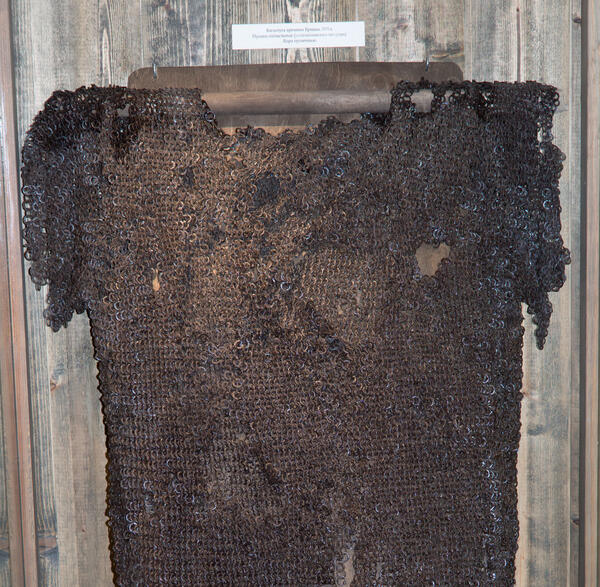The chain mail presented in the museum’s exposition was found in 1938 on the shore of a lake at the bend of the Kama River, within the historic Oryol-town. The creation time of the chain mail is the Yermak era in 1579-1582.
In the Middle Ages, only combat and body protecting clothing was called armor. From the 10th to the 17th centuries in Russia, one of the main types of protective equipment of a warrior was chain mail. There is a legend that the Cossack chieftain Yermak was granted two chain mails by the tsar for the conquest of Siberia, and wore both at the same time.
Historians argue where Yermak’s Siberian campaign began. Many believe that it was the Nizhny ChusovskOy town - a settlement on the banks of the ChusovAya River, the left tributary of the Kama. Other sources point to Oryol-town, a fortress on the left bank of the Kama. Ostrozhek is also indicated by the fact that the soldiers had to be equipped for the campaign, and the combat arsenal of the Oryol-town was significantly superior to the ChusovskOy.
Oryol-town was founded in 1564 by the famous salt manufacturers, the Stroganov. In the XVI-XVII centuries, the town was one of the largest in the Perm region. Among the Komi-Permians, the fortress was known as ‘KergedAn’, that is, ‘the city at the mouth of the river.’
From the chronicle data it is known that 87 people died during the assault of the Bashkirs and Cheremis in Oryol in 1572. In 1580 to protect the patrimony the salt manufacturers Grigory and Nikita Stroganov called on the Great Cossack squadron led by Yermak to Perm.
Archaeological excavations at the site of Oryol-town carried out by the Kama expedition in 1952-1954 revealed fragments of Russian pottery, metal barn locks, quadrels, tiles, coins from the times of Ivan the Terrible and Mikhail Fedorovich, tools, weapons, trunks for salt pipes, ornaments.
The inhabitants of the town were engaged in trade, agriculture, fishing, and salt production. A large number of fragments of tiles and tiles, according to archaeologists, speaks of the prosperity of the population. In the 17th century, one tile was paid as much as half a pound of salt.
The economic prosperity of the Oryol-town was hampered by natural disasters. As a result of neotectonic movements that led to the displacement of the channel of the Kama River, a part of the town was constantly flooded with river and flood waters. At the beginning of the 18th century the population left it.
By 1715 all the churches and houses of wealthy residents from the Oryol-town were moved to the right bank of the Kama, where the modern Oryol is located. Currently, the partially flooded territory of the historic Oryol-town is located on an island in the Kama reservoir.
In the Middle Ages, only combat and body protecting clothing was called armor. From the 10th to the 17th centuries in Russia, one of the main types of protective equipment of a warrior was chain mail. There is a legend that the Cossack chieftain Yermak was granted two chain mails by the tsar for the conquest of Siberia, and wore both at the same time.
Historians argue where Yermak’s Siberian campaign began. Many believe that it was the Nizhny ChusovskOy town - a settlement on the banks of the ChusovAya River, the left tributary of the Kama. Other sources point to Oryol-town, a fortress on the left bank of the Kama. Ostrozhek is also indicated by the fact that the soldiers had to be equipped for the campaign, and the combat arsenal of the Oryol-town was significantly superior to the ChusovskOy.
Oryol-town was founded in 1564 by the famous salt manufacturers, the Stroganov. In the XVI-XVII centuries, the town was one of the largest in the Perm region. Among the Komi-Permians, the fortress was known as ‘KergedAn’, that is, ‘the city at the mouth of the river.’
From the chronicle data it is known that 87 people died during the assault of the Bashkirs and Cheremis in Oryol in 1572. In 1580 to protect the patrimony the salt manufacturers Grigory and Nikita Stroganov called on the Great Cossack squadron led by Yermak to Perm.
Archaeological excavations at the site of Oryol-town carried out by the Kama expedition in 1952-1954 revealed fragments of Russian pottery, metal barn locks, quadrels, tiles, coins from the times of Ivan the Terrible and Mikhail Fedorovich, tools, weapons, trunks for salt pipes, ornaments.
The inhabitants of the town were engaged in trade, agriculture, fishing, and salt production. A large number of fragments of tiles and tiles, according to archaeologists, speaks of the prosperity of the population. In the 17th century, one tile was paid as much as half a pound of salt.
The economic prosperity of the Oryol-town was hampered by natural disasters. As a result of neotectonic movements that led to the displacement of the channel of the Kama River, a part of the town was constantly flooded with river and flood waters. At the beginning of the 18th century the population left it.
By 1715 all the churches and houses of wealthy residents from the Oryol-town were moved to the right bank of the Kama, where the modern Oryol is located. Currently, the partially flooded territory of the historic Oryol-town is located on an island in the Kama reservoir.



